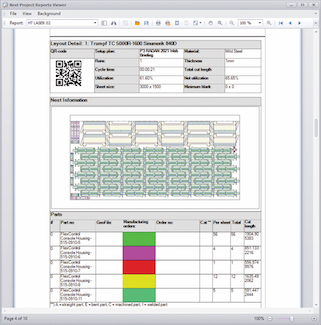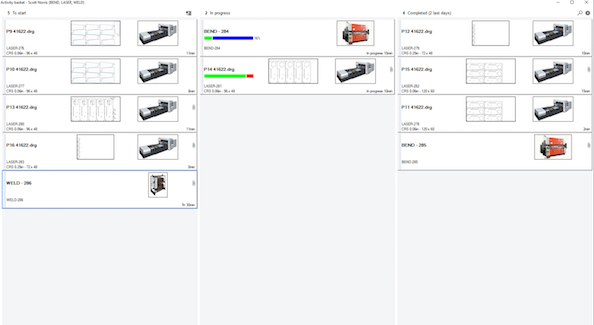You Can’t Create a Comprehensive Digital Thread If You Let This Common Obstacle Get in the Way
Quoting software saves time and money throughout the entire production process if it’s properly integrated with CAD/CAM and manufacturing system software. If it’s not, your team’s doomed to constantly reinvent the wheel.
Posted: June 18, 2020
CAD/CAM INSIDER COLUMN
BY DOUG WOOD
The times in which we find ourselves are indeed different. While I’m sure you’re tired of hearing just how unprecedented our new challenges are, the reality is that manufacturers must be more efficient than ever to remain competitive.
Continuous process improvement tops the list when it comes to gaining efficiency — be that through adopting new technologies, investing in training, implementing automation, maximizing material yield, or all of the above. Although it’s tough (and often expensive) to make changes even in the best of times, there are ways to stay afloat – and even get ahead – without reinventing the wheel.
One of the most-effective is to improve your understanding of how well your business is using what it already has.
Whatever the buzzword or phrase, “smart manufacturing” and “the growth of Industry 4.0” boil down to the ability to collect data in real time and put it to good use. Doing that requires integration. Manufacturers can’t expect to increase profits by using discrete, disconnected islands of technology. They must connect.
Establishing a digital thread that supports production as parts make their way through the shop begins with quotation software. As the conduit that supports all downstream functions, it’s essential the software be linked to computer-aided design (CAD), computer-aided manufacturing (CAM), enterprise resource planning (ERP), manufacturing execution system (MES), and/or material requirements planning (MRP).
From Quote To Fabrication
As with pretty much anything in manufacturing, it all begins with the original design: How much is this going to cost to make? Who can edit the models? Is there revision control?
Answers to these questions begin at square one, where the value of connected systems that reduce or eliminate repetitive tasks is clear.
Estimators typically evaluate geometry — including 3-D models, assemblies, and 2-D parts — during the quoting process. Therefore, quotation software that uses geometry is crucial to producing more accurate results and saving multiple steps down the line.
The software increases productivity by eliminating errors that occur when estimators manually calculate elements like the number of holes to determine pierce times or how many parts can fit on a sheet to determine how much to charge for material. Even slight discrepancies add up to significant loss over time, especially when added to the cost of labor hours invested in a manual process.
Because generating quotes also typically entails running parts through press brake software to confirm the right tooling is available, it makes sense to take advantage of the groundwork you’ve already laid to get started on the job.
Integrated systems make it much simpler to convert completed quotes into orders so those jobs are ready to flow into nesting software.
This connectivity eliminates the need to print and drop travelers off in the programming department, as orders are automatically transferred directly to the nesting software. Likewise, purchase orders are automatically generated for materials needed while time is simultaneously allocated on the machinery required to process the job.
Because it eliminates the need to re-enter information and repeat steps along the way, integrating quotation, MES, and CAM software makes for better use of data and reduces the chance human error will throw a wrench into the works.
Eliminating Double Duty
Because you review the bending process via the press brake software during the quoting process, jobs really start before the customer even receives the quote.
With that data already in hand, it’s simply a matter of confirming the program and getting it ready for the operator to run once the parts have been cut. Setup information and simulation of the bending process are generated with the press brake software during the quoting process, which helps ensure the operator has the data needed to get the job right on the first try.
None of this can happen if you’re stuck moving files between several systems and re-entering data multiple times.
Not integrating quoting software with an MES system potentially adds steps to the process, which prevents your team from receiving accurate, real-time information.
The Road To Integration
When looking for a new quoting, MES, or CAM solution, it’s important to find software that can be integrated with what you already use. If you have just one or perhaps none of those three types of solutions, keep your options open by looking for software that can eventually be integrated with other solutions down the road.
As you research your options, put your top choices to the test by running sample data through the programs to see how they react. Being able to see firsthand how easy it is to make a connection, or for data to flow between programs, is essential for making the best possible choice.
It’s also crucial to determine whether or not a connection is release-dependent. If upgrading one program could break the link to one or both of the other programs, you’ll lose the efficiencies you worked so hard to gain.
Taking advantage of digital tools is all about fully using the data your operation generates to eliminate redundancy and ensure you have the most-complete real-time information possible.

















